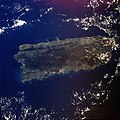STS-34
| Missionsemblem | |||||
|---|---|---|---|---|---|
 | |||||
| Missionsstatistik | |||||
| Missionsnavn: | STS-34 | ||||
| Rumagentur: | NASA | ||||
| Rumfærge: | Atlantis (5) | ||||
| Antal besætningsmedlemmer: | 5 | ||||
| Affyringsrampe: | LC-39A (KSC) | ||||
| Opsendelse: | 18. oktober 1989 | ||||
| Landing: | 23. oktober 1989 | ||||
| Landet på: | Edwards Air Force Base | ||||
| Varighed: | 4 dage, 23 timer | ||||
| Foto af besætningen | |||||
 | |||||
| Navigation | |||||
| |||||
STS-34 (Space Transportation System-34) var Atlantis femte rumfærge-mission. Opsendt 18. oktober 1989 og vendte tilbage den 23. oktober 1989. Det var den 21. rumfærge mission. Om bord var rumsonden Galileo der skulle studere planeten Jupiter dens måner.
Hovedartikler:
Missionen
Klargøring af rumsonden Galileo.
Rumsonden Galileo sættes ud.
Udsigten fra STS-34 der passerer over Puerto Rico.
Besætning

 Donald Williams
Donald Williams
 Michael McCulley
Michael McCulley
 Franklin Chang-Diaz
Franklin Chang-Diaz
 Shannon Lucid
Shannon Lucid
 Ellen Baker
Ellen Baker
Eksterne henvisninger
- STS-34 NASA (engelsk)
| ||||||||||||||||||||
| ||||||||
Medier brugt på denne side
Forfatter/Opretter: Rei-artur (diskussion · bidrag), reshaped by F l a n k e r (talk), Licens: CC-BY-SA-3.0
symbol of Mars. 400 × 400 pixels nominal dimensions, line 45 pixel tick, circle 295 × 295 pixel, not joined with arrow. Colour: red=0 green=0 blue=140.
![]() Vektorgrafikken blev lavet med Inkscape.
Vektorgrafikken blev lavet med Inkscape.
SVG version of PNG Space Shuttle Logo/Patch.
Space Shuttle Atlantis takes flight on its STS-27 mission on December 2, 1988, 9:30 a.m. EST, utilizing 375,000 pounds thrust produced by its three main engines. The STS-27 was the third classified mission dedicated to the Department of Defense (DoD). After completion of mission, Orbiter Atlantis landed December 6, 1988, 3:36 p.m. PST at Edwards Air Force Base, California.
STS-28 mission patch
- The STS-28 insignia was designed by the astronaut crew, who said it portrays the pride the American people have in their manned spaceflight program. It depicts America (the eagle) guiding the space program (the Space Shuttle) safely home from an orbital mission. The view looks south on Baja California and the west coast of the United States as the space travelers re-enter the atmosphere. The hypersonic contrails created by the eagle and Shuttle represent the American flag. The crew called the simple boldness of the design symbolic of America's unfaltering commitment to leadership in the exploration and development of space.
STS-33 Mission Insignia
STS-34 Mission Insignia
Image of Puerto Rico taken by NASA during STS-34
Mission: STS034 Roll: 76 Frame: 88 Mission ID on the Film or image: STS34
Center Point Latitude: 18.0 Center Point Longitude: -66.5 (Negative numbers indicate south for latitude and west for longitude)
Forfatter/Opretter: By Rei-artur (diskussion · bidrag)., Licens: CC-BY-SA-3.0
Venus/female symbol.
The STS-34 crew portrait includes 5 astronauts. Pictured left to right are Shannon W. Lucid, mission specialist; Donald E. Williams, commander; Franklin R. Chang-Diaz, mission specialist; Michael J. McCulley, pilot; and Ellen S. Baker, mission specialist. The crew of 5 launched aboard the Space Shuttle Orbiter Atlantis on October 18, 1989 at 12:53:40pm (EDT). The primary payload was the Galileo Jupiter Spacecraft and attached inertial upper stage (IUS). Deployed 6 hours and 30 minutes into the flight, the IUS stages fired, boosting Galileo on trajectory for a 6 year trip to Jupiter.
In the Vertical Processing Facility (VPF), the spacecraft Galileo is prepared for mating with the Inertial Upper Stage booster. Galileo will be launched aboard the Orbiter Atlantis on Space Shuttle mission STS-34, October 12, 1989 and sent to the planet Jupiter, a journey which will take more than six years to complete.
Galileo probe deployed.
- This photograph was taken by the STS-34 crew aboard the Space Shuttle Atlantis and shows the Galileo spacecraft being deployed on Oct. 18, 1989 from the payload bay. Galileo is a scientific craft that will go into orbit around the planet Jupiter and drop a probe into its atmosphere in search of primordial solar system material believed to be present there. The 70mm motion picture film will be used in the forthcoming "Blue Planet," which will address Earth's environmental problems from the perspective of space-based observation and solar system exploration. The film is being produced by IMAX Space Technology Inc. for the sponsor, the Smithsonian Institution, with funding provided by the Lockheed Corporation.
















